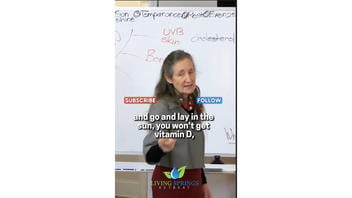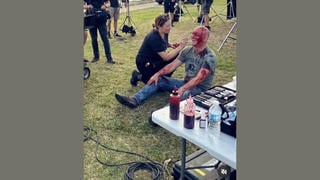
Does taking a shower prevent the skin from absorbing vitamin D from sunlight? No, that's not true: Medical experts confirmed to Lead Stories that vitamin D is made in living cells in the skin and thus cannot be washed off. The person giving this advice is Barbara O'Neill, a controversial naturopath who was banned from practice in Australia.
The claim appeared in a video (archived here) on Instagram on September 11, 2024. Shortly after the video opened, Barbara O'Neill said:
And if you have a shower and wash yourself with soap, washing all your oils away, and go and lay in the sun, you won't get vitamin D because that layer of natural oil is needed on the skin, so there are a few things that we need to be mindful of to be able to access vitamin D.
This is what the post looked like on Instagram at the time of writing:
 (Source: Instagram screenshot captured on Thu Sept 12 18:37:30 2024 UTC)
(Source: Instagram screenshot captured on Thu Sept 12 18:37:30 2024 UTC)
O'Neill is an Australian woman who, despite being an unregistered practitioner, offers health care services.
Michael Holick, Ph.D., M.D. (archived here), a professor at Boston University's Chobanian & Avedisian School of Medicine, is an expert on the biochemistry, physiology, metabolism and photobiology of vitamin D for human nutrition. He told Lead Stories via email on September 13, 2024 that the claim is "absolutely not true." Holick explained:
When you are exposed to sunlight you make previtamin D3 in your living cells not on the surface of the skin. You cannot wash it off.
Referring to O'Neill, Clifford Rosen, M.D. (archived here), professor of medicine at Tufts University School of Medicine, told Lead Stories via email on September 16, 2024, "That person is dead wrong." He explained why the assertion was false:
The oils have nothing to do with the generation of vitamin D. The reaction to convert pro vitamin D to pre vitamin D in the skin is non enzymatic and just involves UVB breaking down vitamin D precursors to previtamin D which can then be metabolized in our body as the active form
No oils are involved or needed. It can be done in a test tube!!!!
Holick is a scientific adviser with the Vitamin D Society (archived here), a Canadian nonprofit that promotes awareness of vitamin D's impact on human health.
In an email dated September 12, 2024, Perry Holman, executive director of the organization, told Lead Stories that Holick specifically addressed the claim about a shower preventing vitamin D absorption after sun exposure in his book, "The Vitamin D Solution: A 3-Step Strategy to Cure Our Most Common Health Problems" (archived here).
Chapter 13, page 254 of the book has a Q&A with the question, "Will I wash off the vitamin D I produce in my skin if I take a bath or shower within thirty minutes of being exposed to sunlight?" Holick's answer was, "No. Vitamin D is made in living cells in the skin. You cannot wash it off!"
Holick also wrote an article (archived here) that stated washing the skin does not affect vitamin D absorption:
During exposure to sunlight solar radiation with wavelengths of 290-315 nm [nanometers] penetrate into the skin and are absorbed by proteins, DNA and RNA as well as 7-dehydrocholesterol. Most of this UVB radiation is absorbed in the epidermis and as a result when exposed to sunlight most of the vitamin D₃ that is produced in the skin is made in the living cells in the epidermis. This is the reason why after exposure to sunlight vitamin D₃ remains in the skin even when the skin is washed with soap and water immediately after the exposure to sunlight.
The National Institutes of Health's guidance on vitamin D (archived here) explains that sun exposure is a source of vitamin D production. The factors that affect vitamin D production include season, time of day, length of day, cloud cover, smog, skin melanin content and sunscreen. Taking a shower and washing the skin are not listed as factors:
Sun exposure
Most people in the world meet at least some of their vitamin D needs through exposure to sunlight. Type B UV (UVB) radiation with a wavelength of approximately 290-320 nanometers penetrates uncovered skin and converts cutaneous 7-dehydrocholesterol to previtamin D3, which in turn becomes vitamin D3. Season, time of day, length of day, cloud cover, smog, skin melanin content, and sunscreen are among the factors that affect UV radiation exposure and vitamin D synthesis. Older people and people with dark skin are less able to produce vitamin D from sunlight. UVB radiation does not penetrate glass, so exposure to sunshine indoors through a window does not produce vitamin D.
Other Lead Stories fact checks about Barbara O'Neill can be found here.
















